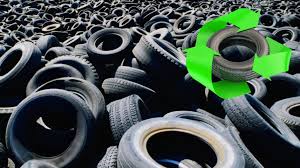Extended Producer Responsibility (EPR) is a policy approach that holds producers accountable for the end-of-life management of the products they manufacture. The concept is applied to various sectors to ensure that the environmental impact of products is considered not only during their use but also at their disposal. Waste tyres, a significant environmental concern worldwide, are one such product category where EPR can play a transformative role. In this article, we explore the application of EPR to waste tyres, its benefits, challenges, and the future of tyre recycling.
Understanding EPR for Waste Tyres
Waste tyres are among the most difficult waste products to manage, primarily because of their volume and longevity. Tyres are durable, non-biodegradable, and often end up in landfills or are illegally dumped, leading to significant environmental damage. Extended Producer Responsibility (EPR) for waste tyres focuses on making tyre manufacturers, importers, and retailers responsible for the collection, recycling, and disposal of tyres once they reach the end of their useful life.
Under an EPR framework, the producers are tasked with the responsibility of establishing systems for the collection and recycling of tyres. This can involve setting up infrastructure for tyre collection, processing, and recycling, as well as funding the costs associated with these activities. Through EPR, the responsibility of managing waste tyres shifts from local governments and taxpayers to the producers, which encourages innovation in waste management and recycling technologies.
The Importance of EPR for Waste Tyres
The waste tyre problem is global. According to the United Nations, millions of tyres are discarded every year, contributing to severe environmental impacts. Tyres, when left untreated, can become breeding grounds for pests, create fire hazards, and even pollute water and soil. The traditional methods of tyre disposal, such as dumping or incineration, are not only environmentally harmful but also inefficient. EPR for waste tyres helps mitigate these risks by promoting a circular economy where tyres are recycled and repurposed, reducing the environmental footprint of tyre waste.
The implementation of EPR for waste tyres provides a structured mechanism for producers to take responsibility for the entire lifecycle of their products. It incentivizes manufacturers to develop tyres that are easier to recycle and reduces the environmental burden associated with their disposal. This policy is crucial for reducing landfill usage and preventing pollution, which can have severe long-term effects on ecosystems and human health.
Benefits of EPR for Waste Tyres
- Environmental Impact Reduction: One of the primary benefits of EPR for waste tyres is the reduction of environmental pollution. Properly managed tyre recycling ensures that fewer tyres end up in landfills, incinerators, or illegal dumpsites. Recycling tyres helps recover valuable materials, such as steel and rubber, which can be reused in various industries, further reducing the need for virgin materials.
- Increased Recycling Rates: EPR programs encourage manufacturers to invest in infrastructure that supports tyre recycling, leading to higher recycling rates. This has the potential to create a closed-loop system in which tyres are continuously reused, rather than discarded.
- Economic Opportunities: By encouraging the recycling and reuse of tyres, EPR programs can also create new economic opportunities. New industries may arise around tyre recycling, leading to job creation in collection, sorting, processing, and remanufacturing. Additionally, the demand for recycled materials such as rubber and steel can boost local economies.
- Incentivizing Product Design: EPR encourages tyre manufacturers to design products that are easier to recycle. This can lead to the development of tyres that use fewer non-recyclable components or are designed to have a longer lifespan. Additionally, it can promote innovations in sustainable materials, contributing to a more sustainable product lifecycle.
- Improved Waste Management Systems: EPR for waste tyres can improve waste management systems by introducing efficient collection and recycling schemes. This can reduce the burden on municipalities and taxpayers who would otherwise be responsible for managing waste tyres.
How EPR Works for Waste Tyres
The implementation of EPR for waste tyres involves several key steps. Producers of tyres are required to take responsibility for the tyres once they are no longer useful to consumers. Here is a general outline of how EPR works for waste tyres:
- Producer Responsibility: Producers are legally obligated to establish systems for the collection and recycling of waste tyres. This could involve creating partnerships with recycling firms or directly investing in recycling infrastructure.
- Collection Systems: A network for collecting used tyres is established, which could include collection points at tyre retailers, automotive repair shops, and waste management facilities. These systems must ensure that tyres are collected safely and efficiently.
- Recycling and Repurposing: Once tyres are collected, they are sent to recycling facilities where they are processed into new products. This could include the extraction of materials such as steel and rubber, which can be used to manufacture new tyres, playground surfaces, road construction materials, and other products.
- Funding Mechanisms: The funding for these collection and recycling systems is typically provided through fees or levies that are charged to consumers or producers. These fees ensure that there is a financial mechanism in place to support the infrastructure and logistics of tyre recycling.
- Monitoring and Reporting: Producers are required to report on the quantities of tyres they place on the market and how many they collect and recycle. Regulatory authorities monitor the effectiveness of these systems to ensure compliance and that targets are being met.
Challenges of EPR for Waste Tyres
Despite the numerous benefits, the implementation of EPR for waste tyres also comes with challenges. Some of these challenges include:
- High Costs: Setting up and maintaining the infrastructure for tyre collection and recycling can be expensive. Small producers may find it difficult to bear the costs associated with EPR programs, potentially leading to an uneven playing field.
- Lack of Recycling Technology: While the technology for tyre recycling exists, it is not always available at a large scale. Developing efficient and cost-effective recycling technologies requires significant investment and research.
- Illegal Dumping: Despite EPR regulations, illegal dumping of tyres remains a persistent issue. This is often due to inadequate enforcement of regulations or the temptation for unscrupulous individuals to avoid disposal fees.
- Global Coordination: Waste tyre management often requires international coordination, especially in countries that import and export large volumes of tyres. Creating harmonized regulations across different countries can be difficult, complicating the implementation of EPR programs.
Future of EPR for Waste Tyres
The future of EPR for waste tyres is promising, but it requires continued collaboration between producers, consumers, and regulatory bodies. As more countries adopt EPR policies for tyres, global recycling rates are expected to increase. Advances in recycling technologies, such as pyrolysis and devulcanization, hold the potential to make tyre recycling even more efficient and cost-effective.
Governments and industry stakeholders must work together to address challenges such as illegal dumping, high costs, and technological gaps. Public awareness campaigns can also play an important role in educating consumers and encouraging participation in tyre recycling programs. By fostering a culture of sustainability and responsibility, EPR for waste tyres can significantly reduce the environmental impact of waste tyres and contribute to a more circular economy.
Conclusion
Extended Producer Responsibility (EPR) for waste tyres represents a crucial step toward solving the environmental challenges associated with tyre disposal. By holding producers accountable for the entire lifecycle of their products, EPR policies promote recycling, reduce pollution, and encourage the development of sustainable technologies. While challenges remain, the widespread adoption of EPR for waste tyres has the potential to create a cleaner, more sustainable world for future generations.

